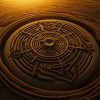Crop circles are mysterious formations that appear in fields of crops, mainly in the United Kingdom and worldwide. These flattened crops have been suggested to be created by aliens, the work of farmers, or even man-made hoaxes.
In this article, we will delve into the history of crop circles, explore the various theories surrounding their creation, and examine the evidence supporting each theory.
The Crop Circle Phenomenon
Crop circles have been appearing for centuries, but it wasn’t until the 1970s that they gained recognition. The first crop circle appeared in Southern England in 1976. Since then, they have become more complex, with simple circles transforming into intricate designs such as the Julia Set pattern.
It is estimated that over 10,000 crop circles have appeared in wheat fields around the world since the 1970s. Most of these formations have been found in Southern England, where the phenomenon gained popularity in the 1980s.
According to Rob Irving, a crop circle enthusiast, and researcher, the shapes of the formations have become more complex over time. Earlier crop circles were simple circles, while newer ones are more intricate and feature elaborate patterns, some resembling the shape of a flying saucer or a burial mound.
Don't miss UFO Sightings Over Ukraine: Unexplained Phenomenon or Government Cover-up?
The Crop Circle Season
Crop circles, also known as crop formations, are patterns created by flattening crops such as wheat, barley, or maize. The phenomenon occurs mainly in Southern England but has also been reported in many other countries worldwide. The formations often appear overnight, ranging from simple circles to intricate and complex designs spanning hundreds of feet. The season when these formations typically appear is from May to September, often corresponding with the growth cycle of the crops.
During the “crop circle season,” farmers are vigilant for unexpected patterns in their fields. Many of them are understandably concerned about the damage to their crops, but others also view these formations as an intriguing spectacle. At the same time, enthusiasts, researchers, and tourists visit the countryside, particularly in regions such as Wiltshire and Hampshire in Southern England, known to be hotspots for these formations. Some visitors even arrange aerial tours to get the best view of the elaborate designs.
Creating a crop circle can be time-consuming, with the duration mainly depending on the complexity of the design. Simple circles might take less than an hour, while intricate formations can require several hours or even days of work. It is commonly believed that most crop circles are man-made, with “circle makers” often working under cover of darkness using simple tools like ropes, wooden boards, and measuring tapes.
However, the origin of crop circles is a topic of debate. While many circles are acknowledged as human artistry and even outright hoaxes, others have remained unexplained, leading to many theories. Some farmers and eyewitnesses have reported unusual occurrences such as strange sounds—like a static buzzing—unexplained lights in the sky, or even electronic equipment malfunctioning.
These unexplained aspects have given rise to speculations ranging from natural phenomena, such as unusual wind patterns or electromagnetic fields, to the more outlandish theories involving extraterrestrials or other supernatural beings. In particular, the alleged association between crop circles and UFO sightings has made the phenomenon a popular topic in the realm of the paranormal and unidentified flying objects (UFOs) enthusiasts.
Crop Circle Depicting
Crop circles come in a variety of shapes and designs. Some are simple circles, while others are complex patterns resembling flying saucers or burial mounds. The most famous designs include the saucer nest, the Julia Set pattern, and the baseball cap.
Some people believe that crop circles are messages from alien life forms, while others think they are intricate works of art created by humans. Skeptics argue that crop circles result from natural processes such as wind or animals or a hoax perpetrated by circle makers.
In 1992, two circle makers, Doug Bower, and Dave Chorley, came forward and claimed to have created the phenomenon in 1978. They used simple tools such as ropes and boards to create the flattened crops. Since then, many others have followed, creating crop circles for fun or profit.
Despite the many theories surrounding crop circles, most are man-made hoaxes. However, some remain unexplained.
Scientific Explanations
Scientists have attempted to explain the creation of crop circles through various theories. Some suggest that they are formed by naturally occurring phenomena such as plasma vortices, while others believe that they result from sound waves or electrostatic charges.
One theory suggests that crop circles are created by the sun’s heat, which causes the plants to wilt and bend. This process, known as phototropism, creates a circular pattern as the plants grow toward the light.
However, many scientists reject these explanations and argue that crop circles are man-made hoaxes. In 1991, the magazine Skeptical Inquirer conducted an experiment to test the theory that natural phenomena create crop circles. They found no evidence to support this theory.
Also read Real Crop Circles – Documenting Some Of The Most Impressive Cases From Around The World
Human Circle Makers
Despite the many theories surrounding crop circles, most are man-made hoaxes. The two most famous circle makers are Doug Bower and Dave Chorley, who claimed to have created the phenomenon in 1978.
Since then, many others have followed, creating crop circles for fun or profit. Some even sell t-shirts and videos of their efforts online.
However, not all circle makers are motivated by profit. Some see it as a creative expression or a way to connect with nature. Graham Brough, a UK-based circle maker, says that he is inspired by the beauty of the landscape and the challenge of creating complex formations.
Crop Circles and Alien Life
The connection between crop circles and alien life has been debated for decades. Some people believe that crop circles are messages from extraterrestrial beings, while others think that they are man-made hoaxes.
Some evidence suggests that crop circles are not of this earth. For example, some formations have been reported to have been created in a single night, far too quickly for humans to have made them. Others have been found with traces of radiation, suggesting that they were created using a high-energy source.
In 1996, two researchers from the UK’s University of Sussex claimed to have found evidence of a crop circle being created by a mysterious ball of light. They reported seeing a glowing object hovering over a wheat field before a crop circle appeared in the same spot. This led to speculation that UFOs were responsible for creating crop circles.
Crop Circles and the Media
The media has played a significant role in shaping public perception of crop circles. In the 1980s, the media portrayed crop circles as mysterious formations created by aliens. However, in the 1990s, the media shifted its focus to circle makers, portraying them as artists rather than hoaxers.
Today, the media is more skeptical of crop circles, often characterizing them as hoaxes or works of art rather than messages from space. However, some media outlets still report on crop circles as if they are genuine mysteries.
Crop Circles Around the World
Crop circles have been reported worldwide, from Australia to Canada. While most formations occur in Southern England, there have been notable examples of crop circles in other countries. For example, a complex formation appeared in an Australian wheat field in 1966, long before the phenomenon gained popularity in the UK.
One of the largest and most complex crop circles ever reported was found in the Netherlands in 2009. The formation measured over 530 feet and featured intricate patterns that took days to create.
Crop Circles and Tourism
Crop circle tourism has become a significant source of income for some communities. People travel worldwide to see the latest designs, stay in local hotels, and eat at local restaurants. Crop circle tourism is estimated to generate millions of dollars in revenue annually.
In Southern England, where most crop circles appear, even guided tours take visitors to see the latest formations. During the crop circle season, local farmers open their fields to visitors, charging a small access fee.
The Future of Crop Circles
The future of crop circles is uncertain. While some people accept the phenomenon as genuine, others see it as a hoax or art form. There is still much debate surrounding the origin of crop circles, with no clear consensus on how they are created.
Despite this, crop circles appear yearly, with new designs becoming more complex and elaborate. Whether they are the work of aliens, humans, or natural processes, they remain a fascinating mystery that captures the imagination of people worldwide.
Crop Circles and Society
Crop circles have significantly impacted society, both in terms of cultural fascination and economic impact. The mystery surrounding their creation has intrigued people worldwide for decades, leading to organizations dedicated to investigating and studying them.
Despite the lack of concrete evidence linking crop circles to extraterrestrial life, many people still associate them with the possibility of alien visitation. This has contributed to a wider cultural interest in the search for extraterrestrial intelligence and has influenced popular culture in various ways, such as in films, books, and television shows.
Related Article Aliens In The Ocean – Discovering How Water May Harbour Signs Of Alien Life Forms
Conclusion
The impact of crop circles is multifaceted, and it isn’t easy to fully gauge their significance. However, it is clear that they have captured the public imagination and have contributed to a wider cultural fascination with the unknown. They have also fueled scientific research into their creation and their potential explanations.
The implications of the crop circle phenomenon are wide-ranging and complex. From a cultural perspective, they have inspired artistic expression and have challenged our understanding of creativity and human ingenuity. From a scientific perspective, they have raised questions about the extent of our knowledge of the natural world and the potential for unexplained phenomena to challenge our assumptions.
The crop circle phenomenon has also highlighted the power of the media to shape public perception and has drawn attention to the need for critical thinking and skepticism. Ultimately, the crop circle phenomenon serves as a reminder of the mysteries that still exist in our world and the importance of continuing to explore and question our reality.
Recommended Further Reading:
Auto Amazon Links: No products found.



